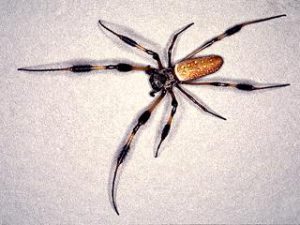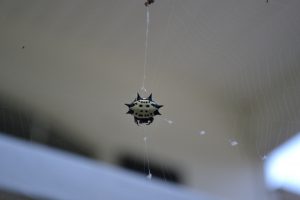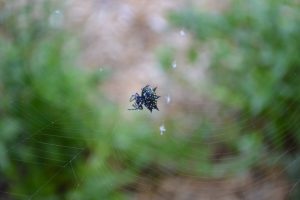
Spider too Close for Comfort
A number of years ago a gentleman told me about an orb weaver spider that was living by his front door. He said that it had been there for about two months and that it was interesting to watch the construction of the intricate “bug catching” web. However, he explained that he had a number of people coming to visit and he wanted to know about relocating the spider to his backyard.
These types of spiders typically construct their webs in an area and stay in that location based on the environment. Many of the orb weaver spiders rely on flying insects and usually construct their webs several feet or more above the ground. This is a good height to capture many flying insects. As a result, there needs to be items within a reasonable distance to attach and place the web. If a spider is randomly relocated, there may be nothing in reasonable distance to support a web. There needs to be at least a couple of tall shrubs or tree trunks for the spider to construct a web in-between the plants several feet above ground level. It needs to be in an area with limited people movement to prevent disturbance by people walking into it. It needs to be in a location with enough flying insect activity to satisfy the spider. If it’s not the right location, the spider may move back to another location, perhaps the front door area.
Webs built by these types of spiders can be quite large and may be suspended several feet or more above the ground. Some people become annoyed and/or frightened as they accidentally come in contact with these webs, brushing the webs from their face and arms. I’m sure the spider becomes annoyed, too, having to rebuild its web.
Despite their size, orb weaver spiders pose little threat to people. They’re considered beneficial because they feed on a wide range of flying insects. They usually construct webs in relatively sunny, open areas with little wind.
Even though these spiders are beneficial, many people don’t like spiders. If you choose to control spiders in and around your home, keep in mind it’s unwise and impractical, if not impossible, to control all spiders.
By the way, the gentleman concerned about the spider decided to leave the spider at the front door area. He posted a sign next to the web in hopes that his guests would steer clear of the web. He offered his garage entrance to those frightened by the spider.
For more information on orb weaver spiders, visit the below UF/IFAS Extension website.




